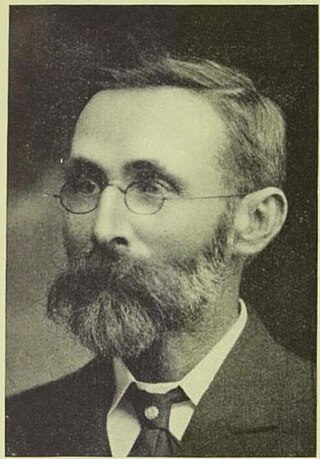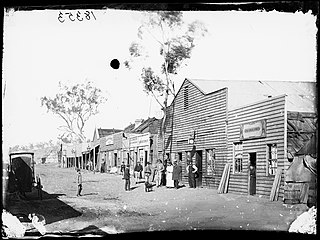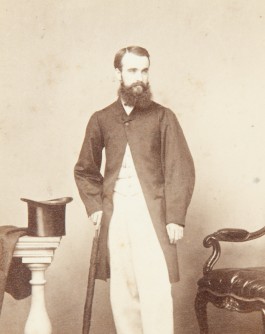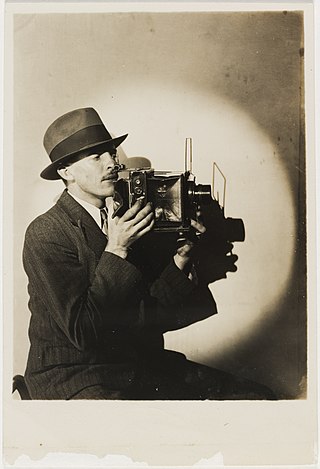
Maxwell Spencer Dupain AC OBE was an Australian modernist photographer.
Mervyn Bishop is an Australian news and documentary photographer. Joining The Sydney Morning Herald as a cadet in 1962 he was the first Aboriginal Australian to work on a metropolitan daily newspaper and one of the first to become a professional photographer. In 1971, four years after completing his cadetship, he was named Australian Press Photographer of the Year. He has continued to work as a photographer and lecturer.

Photography in Australia started in the 1840s. The first photograph taken in Australia, a daguerreotype of Bridge Street, Sydney, was taken in 1841.

Harold Pierce Cazneaux, commonly referred to as H. P. Cazneaux, was an Australian photographer; a pioneer whose style had an indelible impact on Australian photographic history. In 1916, he was a founding member of the Pictorialist Sydney Camera Circle. As a regular participator in national and international exhibitions, Cazneaux was unfaltering in his desire to contribute to the discussion about the photography of his times. His career between the Wars established him as "the country's leading pictorial photographer".
David Moore was an Australian photojournalist, historian of Australian photography, and initiator of the Australian Centre for Photography.

Olive Cotton was a pioneering Australian modernist photographer of the 1930s and 1940s working in Sydney. Cotton became a national "name" with a retrospective and touring exhibition 50 years later in 1985. A book of her life and work, published by the National Library of Australia, came out in 1995. Cotton captured her childhood friend Max Dupain from the sidelines at photoshoots, e.g. "Fashion shot, Cronulla Sandhills, circa 1937" and made several portraits of him. Dupain was Cotton's first husband.

Henri Marie Joseph Mallard was an Australian photographer.

Cecil Westmoreland Bostock (1884–1939) was born in England. He emigrated to New South Wales, Australia, with his parents in 1888. His father, George Bostock, was a bookbinder who died a few years later in 1892.

Henry King was an English-born Australian photographer, known for his studies of Australian Aboriginal people and his views of Sydney. King was one of Australia's most significant early photographers, described by the Australian Photographic Review as "stand[ing] high in the esteem of the craft".

Charles Bayliss, was an Australian photographer, who is best known for photographs that he took during the 1870s, which form a large part of the Holtermann Collection.

Henry Beaufoy Merlin (1830–1873) was an Australian photographer, showman, illusionist and illustrator. In the 1850s he worked as a theatrical showman and performer in Sydney, Newcastle and Maitland. In 1863 he was the first person to introduce Pepper's ghost to Australia. After this, he took up photography and between 1869 and 1872 turned the American Australasian Photographic Company into one of the most respected studios in Australia. Between 1872 and 1873 he worked extensively documenting the goldfields and mining towns of New South Wales. In 1873, as an employee of Bernhardt Holtermann, he photographed Sydney and many rural New South Wales towns. He died on 27 September 1873.

The Holtermann Collection is the name given to a collection of over 3,500 glass-plate negatives and albumen prints, many of which depict life in New South Wales goldfield towns. It also includes numerous photographs of Australian rural towns and the cities of Sydney and Melbourne taken between 1871 and 1876. The collection is held by the State Library of New South Wales.
Sandra Edwards is an Australian photographer. Edwards specialises in documentary photography and photographic curation. Born in Bluff, New Zealand in 1948 Edwards arrived in Sydney in 1961. Edwards was at the forefront of a group of progressive photographers in the 1970s and 80s who were driven to create documentary work that recorded social conditions and had the intent to change these conditions. Edwards' work largely drew from feminist ideals and the media's representation of women as well as the portrayal of Aboriginal communities in Australia.

Axel Poignant was an Australian photographer.

James Sydney Stening was an Australian photographer who was born in 1870 in Sydney. He was then later trained to be a jeweller. Stening's first employment was with Fairfax and Roberts Jewellers, which he decided to stay with until retirement in his older age. He died on 16 September 1953.

Frederick Frith (1819-1871) was an English painter and photographer. He began his career in England but later moved to Australia where he lived in Hobart and Melbourne.

The Australasian Photo-Review was an English language magazine, published for photographers by Baker & Rouse and later Kodak (Australasia), and published in Sydney, Australia 1894–1956.

Milton Kent was a pioneer of industrial and aerial photography, a prize-winning airman and a champion sculler. Initially, Kent worked as a sports photographer but by the 1920s he had embraced aerial photography using a specially crafted oblique camera. Over the next 50 years, Kent used his camera to capture the opening of new blocks of land across Sydney, the construction of the harbour bridge and many other events up until his death in 1965.

Ted Hood was an Australian photographer and photojournalist whose career spanned from 1929 to 1971.
Wesley Stacey was an Australian photographer and photojournalist who was a co-founder of the Australian Centre for Photography. Exhibited widely, including at the Serpentine Gallery, London, Art Gallery of New South Wales, and a retrospective at the National Gallery of Australia in 1991, his work has been collected by the NGA, the National Gallery of Victoria and the AGNSW.



















